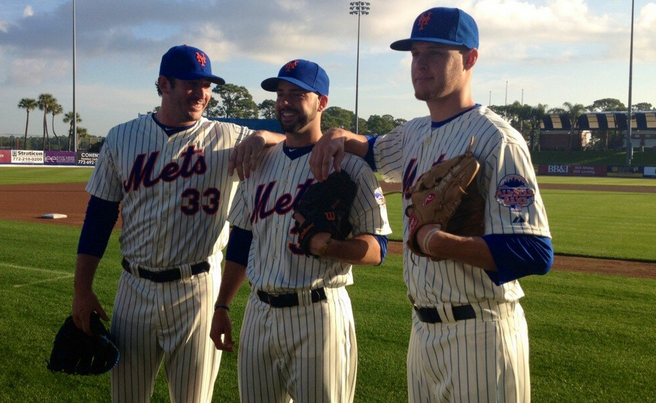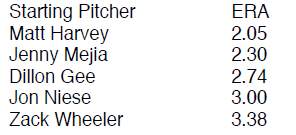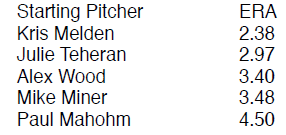
Joel Sherman lauds the Boston Red Sox offense in a piece he did for the New York Post on Monday, suggesting when all is said and done it’s the Sox’ offense that might separate them from the rest of the post season playoff contenders. According to Sherman that’s because strong pitching is a given and an almost automatic trait of every post season baseball team.
Here’s how Sherman started his column:
“The correlation between superb pitching and success remains inarguable.”
He backs up that claim by adding that when it comes to earned run average, the top five teams in the major leagues this year are the National League playoff teams. And, the correlation between strong pitching and baseball success is not limited to the senior circuit. Five of the seven best American League teams also made the post season and the top eight all had winning records.
Those numbers reinforce the Met’s effort to stockpile young quality pitching throughout their minor leagues. With the ace of the starting rotation, Matt Harvey, on the shelf next season, it’s also why the Mets must be extra cautious, extra selective in deciding to move young pitchers as trade pieces to fill position needs on other parts of the field.
When it comes to ERA, in 2013 the Mets finished in the exact middle of the National League, ranking 8th among the fifteen teams. The National League ERA average was 3.73 with the Mets team mark at 3.78.
For the most part, the Mets starting rotation fared well against the league average this summer – a hopeful sign for our future. Of course, Harvey was off the charts with an ERA of just 2.27. But, Zack Wheeler (3.42), Dillon Gee (3.62) and Jon Niese (3.71) all finished beneath the league average mark. Those numbers are likely magnified a tad with Wheeler pitching in his rookie season; Gee getting off to a horrid start; and Niese working through early season injury issues.
Actually, in his small sample of five starts Jenrry Mejia had a sparkling 2.30 ERA, almost matching Harvey. Carlos Torres, filling the fifth rotation spot down the stretch, also finished up with a respectable 3.44 mark. This too bodes well for the Met pitching profile moving forward.
Even more encouraging were the starting pitching ERA totals, post all-star. The performance of the starting rotation during the second half was a big factor in the Mets managing to pretty much play .500 baseball throughout that stretch.


Those impressive ERA numbers helped the five primary Met starters compile a 17 win 15 loss post all-star record. The chart to the right shows the ERA of the first place Atlanta Braves over the same period of time. In terms of earned run average, the Mets starting rotation matched up well with the Division Champs even though the Braves starters went 24-15 over that stretch. That speaks to the point Sherman was making.
Once you have the elite pitching as measured by ERA, then your hitting numbers start to make a difference allowing one elite team to move beyond the others. One point of reference has to be the condition of the Met bullpen. Even though the pen pitched well during stretches, the overall quality of relief work was substandard. That’s especially the case when you consider that Bobby Parnell led the team in ERA at 2.16 and LaTroy Hawkins turned in a remarkable 2.93 ERA, 2.37 after the all-star game. The Mets long relievers and their bridges to get from the seventh inning to the eighth and the eighth inning to the ninth need attention.
The Mets first order of business in getting to the post season and Sherman’s opening premise point the path. I’m optimistic, that’s were the Met rebuild has been focused. The Mets should be cautious about changing course by trading their best natural resource, their young starting pitchers.
That means the Mets should be thinking strongly about using free agency as a strategy of upgrading the roster. International free agents are particularly appealing, probably riskier, but with a bigger upside should things work out – and they won’t cost a draft pick.
Moving our pitching staff to that elite group of the top five is doable. Once we get there we compete. Then is the time to strategically go after the bats to make some Met magic.
Thoughts From Satish R.
I’m a self-declared pitching freak — so a focus on building arms is definitely something that fits my personal philosophy. John is right, as much as we get on the Mets, they’ve produced some strong young pitching recently — and we can continue to produce a few strong arms if some of these prospects pan out. Too much pitching is something that doesn’t exist — if we’ve got enough depth, we’re able to trade prospects past that to improve the MLB team.
Going in 2014, even with Harvey sidelined, we have quite a few options for the rotation considering the Mets want to sign a veteran free agent starter — so at the very least, the entire core of Mets pitchers should be a bright spot next year.
